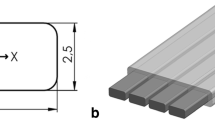Abstract
Carbon fiber reinforced polymer ropes are gaining in significance in the fields of civil engineering and hoisting applications. Thus, methods of non-destructive testing (NDT) need to be developed and evaluated with respect to new challenges and types of defects. Particularly important is the development of in-service testing solutions which allow the integration in global online monitoring systems. Conventional methods like electrical resistivity or strain measurements using optical fibers are already in use. This study investigates the possibility of using various X-ray techniques to increase the reliability and significance of NDT and their applicability to in-service testing. Conventional film radiography is the most common technique; however, even after image enhancement of the digitized film, this technique lacks contrast sensitivity and dynamic range compared to digital detector array (DDA) radiography. The DDA radiography is a highly sensitive method; yet, the limitation is that it delivers 2D images of 3D objects. By the use of co-planar translational laminography the detectability of planar defects is superior to 2D methods due to multiple projection angles. Apart from this, it can be used on-site due to a rather simple setup and robust equipment. In this work two photon counting detectors (PCD) with different sensor materials (Si and CdTe) were used. The results show that the resolution and defect recognition is lower in case of DDA radiography and laminography using PCDs compared to high-resolution computed tomography. However, the DDA radiography and laminography are sensitive enough to both fiber breakage and delaminations and can be significantly advantageous in terms of measurement time and adaptability for on-site monitoring.













Similar content being viewed by others
References
Meier, U.: Carbon fiber reinforced polymer cables: Why? Why not? What if? Arab. J. Sci. Eng. 37, 399–411 (2012). doi:10.1007/s13369-012-0185-6
Rebel, G., Verreet, R., Ridge, I.M.L.: Lightweight ropes for lifting applications. In: OIPEEC Conference (2006)
Mironenko, A., Sukhorukov, V.: Non-destructive testing of steel wire ropes in Russia. Insight Non-Destr. Test. Cond. Monit. 40, 395–397 (1998)
Schmieder, A., Heinze, T., Michael, M.: Failure analysis of high-strength fiber ropes. Mater. Sci. Forum 825–826, 891–898 (2015). doi:10.4028/www.scientific.net/msf.825-826.891
Antin, K.-N., Harhanen, L., Bossuyt, S. Damage detection in CFRP components using DIC. In: Adv. Opt. Methods Exp. Mech. vol. 3, pp. 57–62. Springer, New York (2016)
Otis Elevator Company: Method and apparatus to inspect hoisting ropes. Patent No. US5992574A (1999)
Irving, P.E., Thiagarajan, C.: Fatigue damage characterization in carbon fibre composite materials using an electrical potential technique. Smart Mater. Struct. 7, 456–466 (1998). doi:10.1088/0964-1726/7/4/004
Rebel, G., Chaplin, C.R., Groves-Kirkby, C., Ridge, I.M.L.: Condition monitoring techniques for fibre mooring ropes. Insight J. Br. Inst. Non-Destr. Test. 42, 36 (2000)
Benmokrane, B., Ali, A.H., Mohamed, H.M., et al.: Durability performance and service life of CFCC tendons exposed to elevated temperature and alkaline environment. J. Compos. Constr. 20, 1–13 (2015). doi:10.1061/(ASCE)CC.1943-5614.0000606
ISO 14125:1998 Fibre-reinforced plastic composites—determination of flexural properties
Pärnänen, T., Vänttinen, A., Kanerva, M., et al.: The effects of debonding on the low-velocity impact response of steel-CFRP fibre metal laminates. Appl. Compos. Mater. 23, 1151–1166 (2016). doi:10.1007/s10443-016-9505-4
Bossi, R.H., Iddings, F.A., Wheeler, G.C.: Radiographic Testing. American Society for Nondestructive Testing, Columbus (2002)
ISO 5579:2013: Non-destructive testing—radiographic testing of metallic materials using film and X- or gamma rays—basic rules
ISO 11699-1:2008: Non-destructive testing—industrial radiographic film—Part 1: classification of film systems for industrial radiography
ISO 14096-2:2005: Non-destructive testing—qualification of radiographic film digitisation systems—Part 2: minimum requirements
Taguchi, K., Iwanczyk, J.S.: Vision 20/20: single photon counting X-ray detectors in medical imaging. Med. Phys. doi:10.1118/1.4820371 (2013)
Ullberg, C., Urech, M., Weber, N., et al.: Measurements of a dual-energy fast photon counting CdTe detector with integrated charge sharing correction. Phys Med Imaging (2013). doi:10.1117/12.2007892
Jandejsek, I., Jakubek, J., Jakubek, M., et al.: X-ray inspection of composite materials for aircraft structures using detectors of Medipix type. J. Instrum. 9, C05062 (2014)
Walter, D., Zscherpel, U., Ewert, U.: Photon counting and energy discriminating X-ray detectors—benefits and applications. In: Proceedings of the 19th World Conference on Non-Destructive Testing
Ewert, U., Redmer, B., Walter, D., et al.: X-ray tomographic in-service inspection of girth welds—the European project TomoWELD. QNDE Proc. doi: 10.1063/1.4914650 (2015)
Redmer, B., Ewert, U.: TomoCAR—tomographical computer-aided radiology—a new testing method for the visualisation and sizing of defects in circumferential seams. In: Proceedings of the 6th International Conference on NDE in Relation to Structural Integrity for Nuclear and Pressurized Components
Bullinger, O., Schnars, U., Schulting, D., et al.: Laminographic inspection of large carbon fibre composite aircraft-structures at airbus. In: Proceedings of the 19th World Conference on Non-Destructive Testing
Vavrik, D., Jakubek, J.: Radiogram enhancement and linearization using the beam hardening correction method. Nucl. Instrum. Methods Phys. Res. Sect. A 607, 212–214 (2009). doi:10.1016/j.nima.2009.03.156
Zscherpel, U., Walter, D.: Properties and application areas of photon counting and energy resolving digital detector arrays. Digit. Ind. Radiol. Comput, Tomogr. (2015). http://www.ndt.net/events/DIR2015/app/content/Slides/92_Zscherpel.pdf
Rytter, A.: Vibrational based inspection of civil engineering structures. Fract. Dynam. No. 44, vol. R9314 (1993)
Acknowledgements
The authors would like to acknowledge the support by Sylke Bär and Uwe Ewert of the BAM Bundesanstalt für Materialforschung und -prüfung, Department of Radiological Methods and the Finnish Metals and Engineering Competence Cluster (FIMECC) funded by the Finnish Funding Agency for Technology and Innovation (TEKES).
Author information
Authors and Affiliations
Corresponding author
Rights and permissions
About this article
Cite this article
Schumacher, D., Antin, KN., Zscherpel, U. et al. Application of Different X-ray Techniques to Improve In-Service Carbon Fiber Reinforced Rope Inspection. J Nondestruct Eval 36, 62 (2017). https://doi.org/10.1007/s10921-017-0441-5
Received:
Accepted:
Published:
DOI: https://doi.org/10.1007/s10921-017-0441-5




